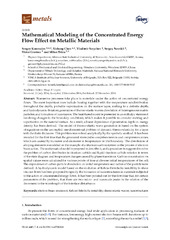Приказ основних података о документу
Mathematical Modeling of the Concentrated Energy Flow Effect on Metallic Materials
| dc.creator | Konovalov, Sergey | |
| dc.creator | Chen, Xizhang | |
| dc.creator | Sarychev, Vladimir | |
| dc.creator | Nevskii, Sergey | |
| dc.creator | Gromov, Victor | |
| dc.creator | Trtica, Milan | |
| dc.date.accessioned | 2018-03-01T17:27:50Z | |
| dc.date.available | 2018-03-01T17:27:50Z | |
| dc.date.issued | 2017 | |
| dc.identifier.issn | 2075-4701 | |
| dc.identifier.uri | https://vinar.vin.bg.ac.rs/handle/123456789/1463 | |
| dc.description.abstract | Numerous processes take place in materials under the action of concentrated energy flows. The most important ones include heating together with the temperature misdistribution throughout the depth, probable vaporization on the surface layer, melting to a definite depth, and hydrodynamic flotation; generation of thermo-elastic waves; dissolution of heterogeneous matrix particles; and formation of nanolayers. The heat-based model is presented in an enthalpy statement involving changes in the boundary conditions, which makes it possible to consider melting and vaporization on the material surface. As a result, a linear dependence of penetration depth vs. energy density has been derived. The model of thermo-elastic wave generation is based on the system of equations on the uncoupled one-dimensional problem of dynamic thermo-elasticity for a layer with the finite thickness. This problem was solved analytically by the symbolic method. It has been revealed for the first time that the generated stress pulse comprises tension and compression zones, which are caused by increases and decreases in temperature on the boundary. The dissolution of alloying elements is modeled on the example of a titanium-carbon system in the process of electron beam action. The mathematical model is proposed to describe it, and a procedure is suggested to solve the problem of carbon distribution in titanium carbide and liquid titanium-carbide solution in terms of the state diagram and temperature changes caused by phase transitions. Carbon concentration vs. spatial values were calculated for various points of time at diverse initial temperatures of the cell. The dependence of carbon particle dissolution on initial temperature and radius of the particle were derived. A hydrodynamic model based on the evolution of Kelvin-Helmholtz instability in shear viscous flows has been proposed to specify the formation of nanostructures in materials subjected to the action of concentrated energy flows. It has been pointed out for the first time that, for certain parameters of the problem, that there are two micro-and nanoscale peaks in the relation of the decrement to the wavelength of the interface disturbance. | en |
| dc.relation | Russian Scientific Foundation [15-19-00065] | |
| dc.relation | Russian Foundation for Basic Research [15-08-03411a] | |
| dc.relation | National Natural Science Foundation of China [51575401] | |
| dc.relation | Zhejiang Provincial Natural Science Foundation [LY16E050007] | |
| dc.rights | openAccess | en |
| dc.rights.uri | https://creativecommons.org/licenses/by/4.0/ | |
| dc.source | Metals | en |
| dc.subject | electron-beam treatment | en |
| dc.subject | Kelvin-Helmholtz instability | en |
| dc.subject | thermoelastic waves | en |
| dc.subject | nanostructures | en |
| dc.title | Mathematical Modeling of the Concentrated Energy Flow Effect on Metallic Materials | en |
| dc.type | article | en |
| dc.rights.license | BY | |
| dcterms.abstract | Громов, Вицтор; Коновалов, Сергеy; Сарyцхев, Владимир; Цхен, Xизханг; Невскии, Сергеy; Тртица Милан; | |
| dc.citation.volume | 7 | |
| dc.citation.issue | 1 | |
| dc.identifier.wos | 000396509900004 | |
| dc.identifier.doi | 10.3390/met7010004 | |
| dc.citation.other | Article Number: 4 | |
| dc.citation.rank | M22 | |
| dc.type.version | publishedVersion | |
| dc.identifier.scopus | 2-s2.0-85009809596 | |
| dc.identifier.fulltext | https://vinar.vin.bg.ac.rs//bitstream/id/11835/1459.pdf |

